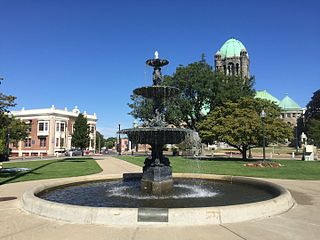
Taunton is a city and county seat of Bristol County, Massachusetts, United States. Taunton is situated on the Taunton River, which winds its way through the city on its way to Mount Hope Bay, 10 miles (16 km) to the south. At the 2020 census, the city had a population of 59,408. Shaunna O'Connell is the mayor of Taunton.

Taunton State Hospital is a psychiatric hospital located on Hodges Avenue in Taunton, Massachusetts. Established in 1854, it was originally known as the State Lunatic Hospital at Taunton. It was the second state asylum in Massachusetts. Most of the original part of the facility was built in a unique and rare neo-classical style designed by architects Boyden & Ball. It is also a Kirkbride Plan hospital and is located on a large 154-acre (62 ha) farm along the Mill River.

The Church Green is a town common in Taunton, Massachusetts. It is a triangular-shaped parcel of land located at the intersection of Summer Street and Dean Street. It has distinctive Veterans Memorials dedicated to both Vietnam Veterans and Global War on Terrorism Veterans. These memorials feature seven flags that are in a V shape, a fountain, a brick garden, reflection benches, the Vietnam Veterans Memorial and the Global War on Terrorism Memorial.
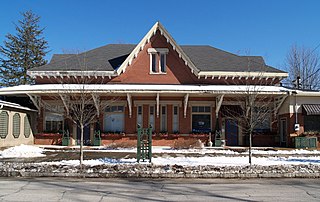
Old Colony Railroad Station is an historic Italianate train station located off Dean Street in Taunton, Massachusetts. The historic station, also known as Dean Street, is proposed to be joined by the modern Taunton station around 2030 as part of Phase 2 of the South Coast Rail project.

The Taunton Green Historic District encompasses the core area of the historic 19th-century commercial downtown business district of Taunton, Massachusetts. It is centered on the town green, laid out in the 1740s, which now serves at the intersection between U.S. Route 44, Massachusetts Route 140, and Route 138. The district was listed on the National Register of Historic Places in 1985.

The Coram Shipyard Historic District is a historic district encompassing a colonial-era shipyard at 2120, 2125, and 2130 Water Street in Dighton, Massachusetts. The district includes two houses, built c. 1700, and the archaeologically sensitive site of a shipyard which operated for a roughly five-year period between 1698 and 1703. The shipyard site is now home to the Taunton River Yacht Club, whose property includes the wharf built by Thomas Coram and John Hathaway, the proprietors of the shipyard. The district was listed on the National Register of Historic Places in 1998.

The Stone House is an historic house at 15-17 Plain Street in Taunton, Massachusetts. Built in 1847, this 2+1⁄2-story stone structure is one of only two stone houses built in Taunton in the 19th century. Its walls are fashioned out of coursed granite, and it has a single-story porch across its front facade, supported by stone piers. It was operated as a hostelry for seamen in the employ of some of Taunton's shipping magnates.

The William Woodward House is a historic house in Taunton, Massachusetts. Built about 1800, it is a prominent local example of Federal period architecture, notably in part for its brick side walls. It was listed on the National Register of Historic Places in 1985.
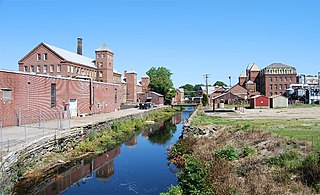
The Reed and Barton Complex is a historic industrial complex at West Brittania and Danforth Streets in Taunton, Massachusetts. It is the site of one of Taunton's first and largest industries, now known as Reed & Barton, a privately held silversmithing business that operated from 1824 to 2015. The company's success was instrumental in Taunton becoming known as the "Silver City". The complex was listed on the National Register of Historic Places in 1984.
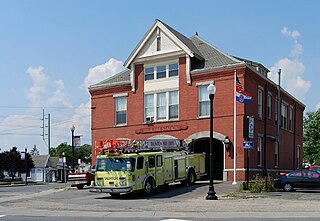
The Weir Engine House is a historic fire station located at 530 Weir Street in Taunton, Massachusetts. It was built in 1889 and added to the National Register of Historic Places in 1984. It is one of two stations in the city, along with the Whittenton Fire and Police Station designed by Taunton's second fire chief, Abner Coleman. It was built by contractor James T. Bassett.
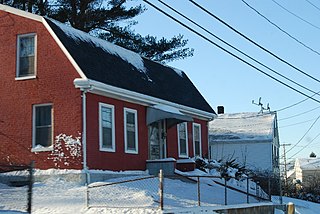
The Capt. David Vickery House is an historic house at 33 Plain Street in Taunton, Massachusetts. It is a 1+1⁄2-story brick structure, five bays wide, with a side gambrel roof. It has Federal style framing around its front windows, with granite lintels beneath windows on the side elevation. The house was built c. 1795 by David Vickery, a captain of seafaring ships who traveled as far as the West Indies. It is a rare surviving brick gambrel from the Federal period, and also rare for its connection to the city's maritime trade.

The Henry Morse House is a historic house located at 32 Cedar Street in Taunton, Massachusetts.
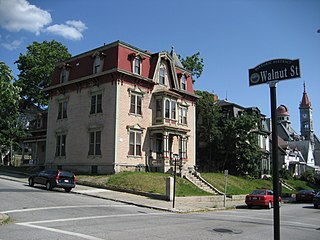
The Highlands Historic District is a historic district roughly bounded by June, Cherry, and Weetamoe Streets, Lincoln, Highland, President, North Main, and Hood Avenues in Fall River, Massachusetts. The district lies just north of the Lower Highlands Historic District.

The Calvin T. Macomber House is a historic house located at 312 W. Brittania Street in Taunton, Massachusetts. It was built in 1885 for Calvin T. Macomber, who was employed at Reed & Barton. It among the most complex examples of the Queen Anne style houses in the city, with an asymmetrical plan and a variety of architectural details. It has a steep hip roof, which is broken up by tall chimneys, projecting sections, and gabled dormers. Second floor windows have trim decorated with floral motifs.

The Jonathan Dean House was a historic colonial American house located at 175 Dean Street in Taunton, Massachusetts, near the Raynham town line. It was a 1+1⁄2-story Cape style house, five bays wide, whose entry was flanked by fluted pilasters, and cornice had a festooned frieze. It was built in 1766 and added to the National Register of Historic Places in 1984. At the time, it was considered to be the most highly detailed 18th century house in the city. However, the house was demolished in the mid-1990s for a pharmacy.

The Dean-Barstow House is a historic house located at 275 Williams Street in Taunton, Massachusetts. It was built circa 1810 for Joseph Dean. The house was constructed from lumber planned and finished at Dean's sawmill located nearby.
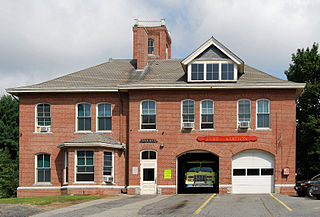
East Taunton Fire Station is a historic fire station located on Middleboro Avenue in the East Taunton section of Taunton, Massachusetts. It was built in 1899 to replace a rented facility that housed the Old Colony Engine Company. It is a two-story brick building, five bays wide, with a hip roof. The rightmost three bays project forward, with a cross-gable hip roof, with the rightmost bays housing engines, and the left bay of the projection providing the main pedestrian entry. The building was added to the National Register of Historic Places in 1984.

The Ambrose Lincoln Jr. House is a historic house located at 1916 Bay Street in Taunton, Massachusetts.
List of Registered Historic Places in Taunton, Massachusetts, which has been transferred from and is an integral part of National Register of Historic Places listings in Bristol County, Massachusetts

First Parish Church is a historic church located within the Church Green Historic District in Taunton, Massachusetts. It is the fourth meetinghouse since 1647 to be located on what was the original town common. The current church building was built in 1830, constructed of field stone in the Gothic Revival style.






















